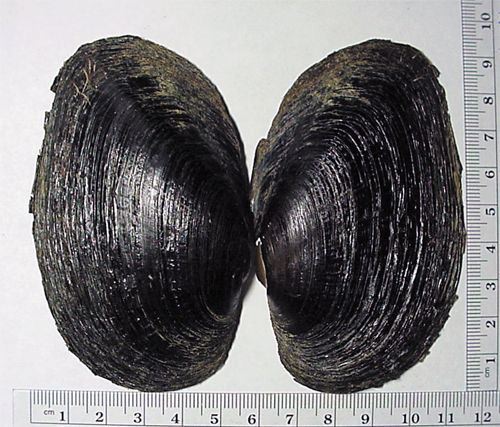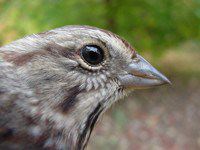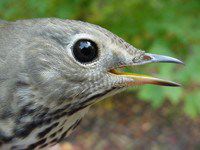 HOME: www.hiltonpond.org |
|||
|
|
THIS WEEK at |
Back to Preceding Week; on to Next Week
Installment #96
 HOME: www.hiltonpond.org |
|||
|
|
THIS WEEK at |
Back to Preceding Week; on to Next Week
Installment #96
|
SHOWING OFF OUR MUSSELS The body of water from which Hilton Pond Center takes its name continues to evaporate under this year's drought conditions; its surface is smaller and lower than any time in the past 19 years. We suspect the various fish in Hilton Pond are starting to get pretty chummy by now; if fish could walk, some undoubtedly would be knocking on the door of our old farmhouse and asking to use the bathtub. 
All photos & text © Hilton Pond Center One "advantage" to having a drastically lower pond level is that its muddy banks are now exposed. We had hoped that would attract shorebirds during fall migration, but none appeared--perhaps because various kinds of herbaceous vegetation quickly colonized the banks. Nonetheless, right at the water's edge is a zone of dark wet mud that this week revealed a new species for Hilton Pond Center--the Eastern Elliptio, Elliptio complanata. Elliptios are mussels--freshwater clams or mollusks--that have two valves (shells) hinged together (below left). Superficially, they look like all the other dark-shelled clams in the world, but the combination of valve size, shape, and color--plus habitat--allowed identification to be narrowed down. Although some Elliptios are among the most endangered or threatened species in the Carolinas, E. complanata (all photos this page) is one of the commonest mussels along the Atlantic Seaboard. Found in ponds and stable, slow-moving streams throughout much of the Carolina Piedmont and Coastal Plain, Like other bivalve mollusks, the Eastern Elliptio is a filter feeder. It takes in large quantities of water through an incurrent siphon, filters out particles (including digestible organic matter), and passes the "purified" water out through another opening. When present in high numbers, the species helps keep water clear and of high quality, much to the benefit of other aquatic organisms, from plankton to fish to River Otters. A most interesting aspect of freshwater mollusks is that for a portion of their lives they don't just lie quietly pumping water on pond bottoms. At an appropriate time, mature male Eastern Elliptios release huge clouds of sperm, some of which are sucked up by the intake of a female mollusk; eventually, viable sperm reach an internal chamber where the eggs await. Fertilized eggs are transferred to the female's gill chamber and a modified brood pouch called a "marsupium," where each develops into an embryo and eventually becomes a larval form called a "glochidium." Sometimes a glochidium simply floats into the fish's mouth, or sometimes it uses an "adhesive hair" (above right) to attach to a fish's fin when it swims over the glochidium on the pond bottom. In some mussel species, the female collects her glochidia around the edge of her shell in soft tissue, or within a jellylike matrix that resembles a succulent worm. In either case, the fish bites at a potential meal and instead gets a mouthful of glochidia that migrate to the fish's gills. After parasitizing the host for several months or more, larval mussels metamorphose, becoming miniature replicas of their parents. At this point they depart the fish host and settle down to a more sedentary life of filter feeding. Different fish are parasitized by different mussel glochidia. The Carolinas host for Eastern Elliptio is not known, but it is probably a widespread species or group of species that may include the sunfishes. As Hilton Pond continues to dry up, more and more Eastern Elliptios are exposed along its banks. An adult mussel can move through mud by burrowing with its muscular foot, but some appear to get stranded between tree roots or debris as the water level drops. These Elliptios become potential food for Muskrats, Raccoons, and River Otters, but only if the predators can get between the edges of a mussel's tightly sealed shells. More than one Eastern Elliptio specimen we found had fresh scratch marks (above left) on one or both valves--a sure sign something was trying to get in. Freshwater mussels apparently can last for several days out of water, but eventually the animal within dies and the shell pops open--making it a much easier meal for that hungry 'coon.
All photos & text © Hilton Pond Center A dead, empty Elliptio shell from Hilton Pond (above) is yet another wonder to behold, for its inner surface is pinkish and iridescent--what is commonly called "mother-of-pearl." Because of this, field biologists spent countless hours during the early 20th century surveying the nation for freshwater mussels--which once were the raw material for buttons for shirts and blouses (below left).At one time 200 small factories in the U.S. were all making "pearl" buttons from mussels. Had plastic buttons not been invented in the 1940s, several freshwater mussel species might have disappeared because of over-harvesting by buttonmakers; in fact, some species likely have not yet recovered. If an Eastern Elliptio can withstand button- makers, pervasive pollution, and persistent predators, it may get relatively large, and "large" means "old." Mussels with a shell length of more than four inches may have reached the advanced age of 15 years or more. The one in the photos above is 4.25" from end to end; that a freshwater clam can live long enough to get that big is hard to imagine. The imagination is REALLY challenged when we consider this: the water impoundments at the Center were built about 1960 and their only sources for replenishment are an undependable spring and rainwater runoff. So now we have two related mysteries to solve: 1) how did the great grandparents of all these Eastern Elliptio get into Hilton Pond 46 years ago, and 2) for that matter, how did their obligate fish hosts get here, too? When you have plausible answers for this two-part question, send them to EDUCATION. It will be interesting to see if anyone believes the Eastern Elliptio can fly like an eagle. All text & photos © Hilton Pond Center Comments or questions about this week's installment?
"This Week at Hilton Pond" is written & photographed You may wish to consult our Index of all nature topics covered since February 2000. You can also use the on-line Search Engine at the bottom of this page. For a free, non-fattening, on-line subscription to "This Week at Hilton Pond," just send us an E-mail with SUBSCRIBE in the Subject line. Please be sure to configure your spam filter to accept E-mails from hiltonpond.org. |
|
Make direct donations on-line through
Network for Good: |
|
|
LIKE TO SHOP ON-LINE?
Donate a portion of your purchase price from 500+ top on-line stores via iGive: |
|
|
Use your PayPal account
to make direct donations: |
|
|
White-breasted Nuthatch SPECIES BANDED THIS WEEK 
Song Sparrow |
WEEKLY BANDING TOTAL YEARLY BANDING TOTAL (2001) 74 species 1,243 individuals BANDING GRAND TOTAL 
Hermit Thrush NOTABLE RECAPTURES |
|
Up to Top of Page Current Weather Conditions at Hilton Pond Center |
|
|
 You can also post questions for The Piedmont Naturalist |
Join the |
Search Engine for |
|
|